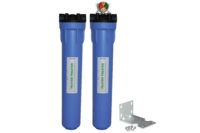GALESBURG, Ill. — The COVID-19 pandemic forced K-12 schools to not only close their doors suddenly and unexpectedly, but to keep them closed for an unusually long period of time. Due to the prolonged shutdown, stagnant water left sitting in the pipes and plumbing systems of school buildings now poses a great threat of Legionella bacteria growth which can cause Legionnaires' disease, a type of severe pneumonia that can lead to death. Though there is always a risk of Legionella in stagnant water systems, schools may be at a much higher risk now due to the several months-long closures and continued low-occupancy which may allow for higher concentrations of Legionella to develop.
As schools across the country work to reopen, Intellihot implores K-12 school administrators to take preventative health and safety measures, such as proactively flushing all piping and water-using devices and to consider long-term solutions like tankless hot water heaters in order to minimize the risk of Legionnaires’ disease and other waterborne hazards and diseases.
In just the past 30 days, Legionella has already been found in at least 10 schools in multiple towns in New York, Ohio and Pennsylvania and experts predict there will be more. A report from the National Academies of Sciences, Engineering, and Medicine titled Management of Legionella in Water Systems, estimates that about 52,000 to 70,000 Americans suffer from Legionnaires’ disease each year. According to Centers for Disease Control and Prevention (C.D.C.), in the United States, the rate of reported cases of Legionnaires’ disease has grown by nearly nine times since 2000. Dr. Andrew Whelton, an associate professor of civil engineering and environmental and ecological engineering at Purdue University, has studied the implications of water stagnation in school plumbing systems and has been vocal about the action school administrators and public health officials should take to reduce the risk for widespread disease before students, teachers and staff return to school.
“Widespread building shutdowns brought on by COVID-19 are unprecedented,” said Whelton. “Buildings aren’t designed for these shutdowns, and water needs to stay moving to prevent bacteria and metal from concentrating in the pipes. Students and staff could be at risk of serious health issues if pipes aren’t properly flushed before they return. Even when schools reopen, fewer people in the buildings means lower water use. Problems need to be avoided with operating buildings at low occupancy, too.”
The most common form of Legionella transmission occurs by breathing in contaminated water droplets or mist from sources such as drinking fountains, sinks, and showers. Legionnaires’ disease cannot be spread from human-to-human contact and the majority of cases can be successfully cured with antibiotics. However, because Legionnaires’ disease shows similar respiratory signs and symptoms as COVID-19, there are additional concerns that those with Legionnaires’ disease may be misdiagnosed with COVID-19 and thus, left untreated.
“Legionnaires’ disease is very preventable. With a few simple steps and inexpensive precautions, school administrators can reduce the risk,” said Sri Deivasigamani, co-founder and CEO of Intellihot. “If you haven’t already considered a tankless water heating system as part of your school’s water management plan, now is the time to do so. In addition to health and safety benefits, Intellihot tankless units save money, improve your school’s carbon footprint and can be quickly installed before occupants return.”
Though there are currently no government or industry standards for schools to safely reopen and to return plumbing to normal use following the extended closures, the CDC has published voluntary guidelines to aid building owners and property managers aiming to prevent Legionella from spreading as facilities reopen.
Want more HVAC industry news and information? Join The NEWS on Facebook, Twitter, and LinkedIn today!










